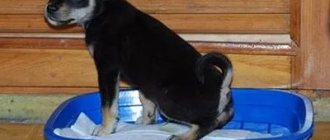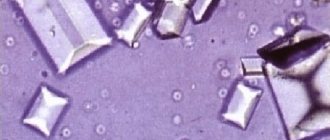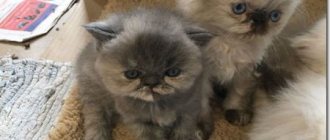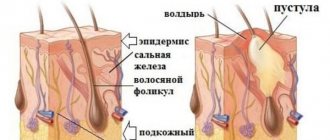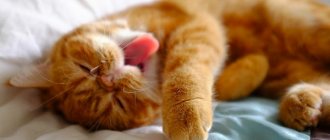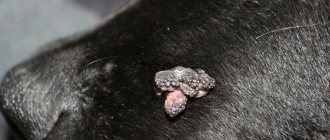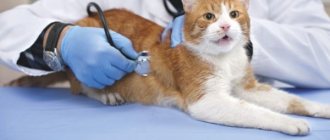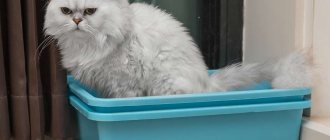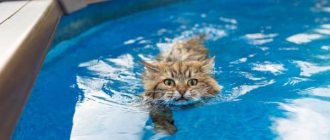6987Administration
The phenomenon of increased protein in a cat's urine is called proteinuria. Protein particles are small, they easily pass through the glomeruli and are therefore excreted along with the urine. If the urine contains protein in small quantities, then this is normal and a physiological process. When protein levels are elevated, this indicates health problems in the cat. In such a situation, it is important to identify the cause of the problem and provide quality treatment.
There are quite a lot of factors for the occurrence of a disorder, and only a veterinarian, after carrying out the necessary tests, will be able to determine why a cat’s urine contains increased protein. The disorder also occurs in dogs.
© shutterstock
Causes
The appearance of changes in the composition of urine, in which increased protein excretion occurs, is caused by various problems and further worsens the condition of the sick cat. Protein, washed out of the body along with urine, is present in the blood. Violation of its secretion is an indicator of a serious problem. The main reasons for the occurrence of pathology are as follows :
- systemic diseases, such as systemic lupus erythematosus, which also affects the kidney;
- chronic bacterial lesions of the body, especially the urinary and circulatory systems;
- infectious pathologies such as Lyme disease or ehrlichiosis;
- diabetes mellitus – older cats are most often affected;
- pathologies of the pituitary gland, including Cushing's disease;
- persistent increase in blood pressure - hypertension occurs not only in humans, but also in cats, most often over the age of 10 years;
- hereditary predisposition to the appearance of disorders in the process of urine production;
- inflammatory pathologies of the kidneys, including urolithiasis;
- inflammatory pathologies of the circulatory system are a fairly common reason that urine contains protein above normal;
- persistent disturbances in the metabolism of proteins and carbohydrates, against the background of which excessive deposition of amyloid occurs in the internal organs.
The older the pet, the higher the likelihood that he will develop disorders in which the urine contains excess protein.
This is interesting: How to treat rhinotracheitis in cats?
Causes of protein in cat urine
If the level of protein in the urine even reaches the upper limit of normal, we are not yet talking about the disease. A pathology is considered to be the presence of it in an amount that far exceeds the permissible value; this condition is called proteinuria.
Protein in the urine can be one of the symptoms of such diseases:
- cystitis;
- urethritis;
- pyelonephritis;
- glomerulonephritis;
- renal amyloidosis (disorder of protein-carbohydrate metabolism);
- urolithiasis disease;
- anemia;
- infectious diseases (erlichiosis, Lyme disease);
- high blood pressure;
- pyometra (one of the dangerous forms of endometritis);
- lipemia (presence of lipids in the blood);
- systemic lupus erythematosus;
- diabetes;
- oncological diseases of the genitourinary system.
Tests confirming the significance of proteinuria
If the test is positive and proteinuria is confirmed, urinary protein excretion should be quantified.
This helps determine the severity of kidney disease, as well as the dynamics of treatment. A method is used to determine the urine protein:creatinine ratio.
Creatinine synthesis is a constant process, since muscle mass is not subject to daily changes. At the same time, it is freely filtered in the glomeruli without significant secretion or reabsorption in the renal tubules. Urinary creatinine concentration correlates with urine volume and concentration.
The method consists of dividing the concentration of protein in the urine (in mg/dL) by the concentration of creatinine in the urine (in mg/dL), thereby making the effect of urine volume and urine concentration on the concentration of protein in urine significantly small. In the laboratory, the content of creatinine and protein in the urine is determined, the concentrations of both substances are expressed (in mg/dL) and the ratio is calculated.
additional information
In addition, if an animal has an increased protein content in its urine, then it is important to additionally pay attention to the transparency of the excreted urine. The thing is that it has the property of becoming cloudy in the presence of certain impurities in it, which include not only leukocytes, but also salts.
If there is a salty sediment in the urine, the animal can accurately determine urolithiasis, which in most cases affects cats. Pets who have previously been neutered are at risk. This can be explained by the fact that a sharp decrease in activity as a result of this type of operation leads to a sedentary lifestyle and overeating of the animal, which most often occurs when a certain diet is not followed.
Etiology of the process
After determining and confirming proteinuria, it is necessary to identify the place of origin of the pathology in the urinary system, from which the pathological process comes.
Fig. 1 – Ultrasound of the kidney of a German dog. 8 year old shepherd dog, example of the cause of postrenal proteinuria. The picture shows pyeelectasia, the onset of hydronephrosis of the kidney due to obstruction of the ureter by a tumor
Proteinuria is classified into:
- Physiological proteinuria.
- Prerenal proteinuria.
- Postrenal proteinuria.
- Renal (renal) proteinuria.
1. Physiological proteinuria - can occur due to increased physical activity, fever, stress, exposure to excessive heat and cold. This is benign proteinuria and often disappears after the underlying cause is corrected.
2. Prerenal proteinuria is the entry of pathological protein concentrations into the kidneys from blood plasma. Small proteins with low molecular weight pass through the glomerular filtration barrier and increase the absorptive capacity of the proximal tubules of the kidneys.
3. Postrenal proteinuria
The passage of protein into the urinary tract below the kidneys (bladder, urethra, ureters). Most often occurs due to inflammation of these parts of the urinary tract, most often caused by a bacterial infection.
Also, postrenal proteinuria can be caused by nephroliths and tumors (Fig. 1); both of these diseases can be accompanied by infection.
4. Renal proteinuria is caused by abnormal processes in the kidneys. The cause of the appearance of protein in the urine is impaired renal function or inflammation of parenchymal tissue.
It can be functional and pathological.
- Functional: response to a temporary phenomenon.
- Pathological: impaired renal structure or function.
Divided by:
- Glomerular: damage to the glomerular capillary wall.
- Tubular: impairment of tubular reabsorption.
- Glomerular and tubular at the same time.
- Interstitial: proteins enter the urine from peritubular capillaries (acute or chronic nephritis).
Types of proteinuria
Proteinuria can be functional (physiological) and pathological. The first is harmless; it is a temporary reaction to sudden physical activity, overheating, hypothermia, or food high in protein. The indicator usually returns to normal when the provoking effect on the body stops, for example, when the cat’s diet changes.
The pathological form develops against the background of any disease and is divided into:
- Prerenal, when small protein molecules enter the kidneys from the blood, penetrating through the filtration barrier.
- Postrenal - protein fractions are formed in the urinary tract as a result of their inflammation. Most often, this form develops due to a bacterial infection.
- Renal, which is caused by functional or anatomical disorders of the kidneys. In this case, the appearance of protein in urine is the result of inflammation or damage to parenchymal tissue.
Symptoms
The manifestation that the urine has increased protein is similar in symptoms to the signs of many pathologies, which makes it impossible to make an accurate diagnosis based on them alone. Symptoms that suggest that a cat has proteinuria are:
- lack of appetite;
- frequent vomiting;
- rapid weight loss;
- severe weakness;
- apathy and lethargy.
As soon as the first causes of a disorder in the cat’s body have been identified, it is necessary to urgently visit a veterinarian for a diagnosis and quality treatment before it is too late. In some cases, when the urine contains protein in particularly large quantities, and the pet’s condition is very serious, and therapy will definitely not produce results, the question of euthanizing the cat may be raised to stop its suffering. The presence of excessive protein in the urine is a serious phenomenon for a cat.
Diet and nutrition for cats with chronic renal failure
Treatment must be supplemented with nutrition; this is adjunctive therapy. Because the cat refuses to eat, the body is severely depleted. Therefore, even force feeding is appropriate.
If the test shows a urea level of less than 20 mol/l, feeding very high quality wet food is acceptable. When the condition stabilizes, we can switch to premium dry food.
At 30 mol/liter, STRICTLY a protein-free diet based on sweetened foods and flour products. If the cat is not picky about food, bread, oatmeal pancakes, pasta with the addition of vegetable oil are suitable for her. If she does not accept such food, then canned cat food in diluted form. To support the stomach and digestion - Creon and Mezim.
Mix 100 ml of purified water with the same amount of 2.5% fat milk, add sugar - a tablespoon and potato starch - 1 teaspoon. Boil everything, cool. Beat in a raw chicken egg and 1 crushed Mezim tablet.
Mix the mixture thoroughly and give the cat 5 ml through a syringe every hour. As soon as the vomiting decreases or disappears and the condition improves, you can increase the dose, while reducing the interval between feedings. When the condition normalizes, transfer the cat to wet food.
Treatment of kidney failure in cats must be carried out by a veterinarian. The effect of drugs should be monitored by collecting tests. At home, you will not provide help to the animal - arrogance will be fatal for the pet.
Bring your animal to the clinic regularly for control tests. By noticing the disease at an early stage, you can prevent the degeneration of kidney tissue and get by with supportive therapy. Special control must be provided to animals of the Persian breed.
Diet in the treatment of chronic renal failure is one of the most important ways to maintain the patient’s health and prolong his life.
Since the changes that occur in the kidneys during chronic renal failure are largely irreversible, the most important goal of treatment is dietary support. After detoxification therapy, regulation of blood pressure and electrolyte balance, it is very important to reduce the protein and mineral load on the kidneys, since kidneys in chronic renal failure mainly cannot cope with the removal of protein breakdown products - urea and creatinine.
There are a number of medicated foods specifically designed for cats with chronic renal failure. In our practice, we use diets from such feed manufacturers as Royal Canin, Hill's, Purina, Eukanuba.
Author of the article: Veterinary surgeon Anton Valerievich Bessonov
Diagnostics
The list of diagnostic tests is determined by the veterinarian. The initial diagnostic method is a general urine test. A rapid test for the presence of protein in urine, which is carried out with a paper pH strip, does not always give a reliable result and does not provide quantitative data.
If proteinuria is suspected, the cat is prescribed bacteriological and chemical urine tests. The following indicators are determined:
- color;
- transparency;
- density;
- acidity (pH);
- character of sediment;
- protein;
- slime;
- epithelium;
- fat and ketone bodies;
- presence of blood elements;
- “liver” pigment bilirubin;
- glucose.
Attention! To ensure that the results of a urine test for protein do not turn out to be false, it is not recommended to feed the animal with food containing a lot of proteins for at least a day before collecting it. This is poultry, liver, cottage cheese, milk, eggs.
Differential diagnosis of proteinuria may also include general and biochemical blood tests, ultrasound, x-rays and other studies.
This is interesting: What to do if a cat has a wen on his stomach?
Therapeutic measures
If a pet is suspected of having proteinuria, the veterinarian will prescribe comprehensive treatment. But before doing this, the specialist will conduct the necessary diagnostics. It includes:
- Research on the amount of carotene.
- Urine analysis for protein levels. Its decoding is carried out by a specialist who helps to identify the content of the substance and its overall density.
- Pressure level measurement.
- Conducting a blood test that helps determine the overall physical condition of the pet. The information received is deciphered in the laboratory or by the veterinarian himself.
- Detection of creatinine, protein, in cat urine using biochemistry.
DETAILS: What is urological massage and what is it for » Urological portal No. 1
If necessary, the veterinarian prescribes additional diagnostics, for example, ultrasound and general urine examination, which help identify stones in the body. All important tests and examinations are determined by the doctor who is treating the animal. When the norm of protein in a cat’s urine is the upper limit, there is no point in talking about any disease. This is acceptable, therefore, with such indicators, there cannot be pathology.
Let's see what measures specialists usually take when detecting protein in a cat's urine. Treatment begins immediately after the exact cause of the illness is established. In this case, it is important to determine whether proteinuria is oncological in nature. If a problem with the amount of protein in an animal’s urine occurs due to kidney cancer, then treatment will be effective only in the early stages of the disease.
If a specialist determines that a cat has problems with blood pressure, then he is prescribed a restorative course of treatment using special means. Your pet may also need a change in diet, from which salt and fats should be excluded. At the same time, to restore the animal’s body and improve its condition, medications with omega-3 fatty acids are prescribed. The supplement should be given to your cat daily.
Treatment
Proteinuria is most often treated on an outpatient basis. If a disease is discovered that affects the kidneys' ability to process waste (such as glomerular disease), dietary changes may be recommended. Conversely, if a cat's kidney is inflamed or there is a high risk of infection, antibiotics may be prescribed.
If the problem is determined to be glomerular disease (eg, glomerulonephritis in cats), dietary changes will be extremely effective. The cat's diet will be low in protein and sodium and high in omega-3 fatty acids.
The cat should be closely monitored as rare but serious complications such as swelling, blood clots, high blood pressure and progressive kidney disease may occur.
History, character and description of the Siamese cat breed.The origin story of the “Siamese princess” is surrounded by beautiful legends, speculation and intrigue. There is a legend about Thai princesses who, while bathing, strung their rings on the tails of the royal cats. This is how the Siamese cat's tail defect is explained. But to this day, not everyone knows that this trait is not an adornment of the breed, but its misfortune. It is also unknown how the Siamese cat came to Europe and where its true homeland is. There is a version about a high honor bestowed upon an English subject who was given a pair of Siamese cats by the royal family. Along with this, traces of these cats are not traced in the monastery of the Siamese king. What is the actual truth? Only they know this. Wise, sophisticated, mysterious blue-eyed Siamese cats...
As for the facts, the first pair of Siamese were actually brought to England by British subjects from Thailand. And it was there in 1871 that she was first shown at the first ever cat show at the Crystal Palace. In the exhibition catalog that has survived from those times, there is a description of two representatives of this breed. A year later, an article was published about Siamese cats entitled “Oddly Colored Shorthaired Cats.”
And although all the stories about the origin of these cats are unconfirmed, one thing is certain - Siamese cats have existed in Siam for a long time. However, where can one deal with cats if the history of ancient Siam itself is shrouded in mystery? Colonization, wars... Unlike neighboring countries, justifying its second name - Muang Thai (Land of the Free), Siam has never been anyone's colony. During the reign of 33 kings, its capital Ayutthaya became one of the largest cities in the world. Perhaps Siamese cats were a common pet among the inhabitants of the ancient city. After the ascension to the throne of General Chakri, who laid the foundation for the reigning dynasty and was named Rama I, the modern capital of Thailand, Bangkok, was founded. Its National Library houses authentic manuscripts of ancient Ayutthaya. In the manuscript stored there, known as “The Book of Poems about Cats,” among the descriptions of the cats of this country there are Siamese. Magnificent miniatures depicting cats with dark brown markings on the face, ears, paws, tail and a wonderful light body color present to our contemporaries the appearance of Siamese cats of those times.
As for the status of the Siamese cat in ancient Thailand, there are many versions on this matter. One of them suggests that these cats in the past belonged exclusively to the kings of ancient Siam and enjoyed special privileges. Their export was strictly prohibited and punishable. And only in case of special encouragement of his subjects for faithful service or services rendered could the king give them a Siamese cat. However, similar versions exist in relation to other eastern breeds of this Indochinese Peninsula. Korat, Burmese, Siamese... Which of them was really awarded the honor of being a royal cat? The information is contradictory... Be that as it may, all these breeds have identical exceptional qualities - special, unique beauty, nobility of soul, extraordinary intelligence and truly “dog-like” affection for humans. Among them, slender, chiseled Siamese, striking with their “sculptural” beauty, are deservedly called “princes of the cat kingdom.”
However, it would be a misconception to say that Siamese cats originate exclusively from Siam. Similar cats were found in other regions of Southeast Asia. And not only there. Peter Simon Pallas was a German biologist, geographer and traveler. Studied in Germany, Holland, Great Britain. Having moved to Russia in 1767, he was elected academician of the St. Petersburg Academy of Sciences. In 1768-1788 he led the expedition of the Academy of Sciences, which traveled from Eastern China, through Mongolia, Altai, the Urals, to the Caspian Sea. During his travels, Peter Simon collected (and subsequently processed) a huge amount of geographical, geological, botanical, zoological, ethnographic and other materials. Pallas published the results of his research in a book, which, following the fashion of the era, bore the very detailed title “A Journey through the Southern Provinces of the Russian State in the Period 1773-1788.” In the area of the Caspian Sea, near the settlement of Insar, Pallas met a cat similar in description to the Siamese: “This cat is of medium size, it has longer and thinner legs than those that we are used to seeing in an ordinary cat, it has a long and narrow head . The tail is 3 times longer than the head. The coat color is dark brown, similar to the color of mink, but richer on the face and tail and lighter on the sides and belly. On the chest there is a white medallion. The nose is covered by a black mask that also surrounds the eyes and ends in a pointed triangle on the forehead. The ears, paws and tail are very dark in color. The texture of the coat is more pleasant than that of an ordinary cat, and resembles the smooth, shiny fur of a mink. The undercoat is soft and lighter in color. The hair on the tail is short, smooth, and close-fitting.” The cat from the engraving illustrating these notes also resembles the Siamese cat from the miniatures of ancient Ayutthaya.
Thus, we can only assume that the homeland of the Siamese cat is indeed Thailand, but we should not be absolutely sure of this.
We return to England in 1885. Reports at the time about the Crystal Palace cat show claimed that it was the largest exhibition of those years, attracting approximately 480 participants. A pair of Siamese named Pho and Mia (which means Father and Mother in Thai, owner Mrs. LJ. Ve1ey-Gou1d), who by this time had already given birth to three kittens, became a sensation at the show: they won the champion titles. Mia was "Best Shorthair in Show", "Best Club Shorthair", won the NCC (National Cat Club) Gold Medal and the Wedgwood Tea Service presented by the Crystal Palace to the Best Shorthair in Show, and Pho was second in all of these. nominations. Unfortunately, this was their only triumphant performance. Soon after the exhibition they died.
Reports at the time about the Crystal Palace cat show claimed that it was the largest exhibition of those years, attracting approximately 480 participants. A pair of Siamese named Pho and Mia (which means Father and Mother in Thai, owner Mrs. LJ. Ve1ey-Gou1d), who by this time had already given birth to three kittens, became a sensation at the show: they won the champion titles. Mia was "Best Shorthair in Show", "Best Club Shorthair", won the NCC (National Cat Club) Gold Medal and the Wedgwood Tea Service presented by the Crystal Palace to the Best Shorthair in Show, and Pho was second in all of these. nominations. Unfortunately, this was their only triumphant performance. Soon after the exhibition they died.
Further breeding of this breed continued with the acquisition of many new color variations and improvement of the exterior. It should be said that there are only two breeds that rapidly change their original appearance: Persians and Siamese with Orientals (which are a colored variation of Siamese). It is here that breeders in their work strive to achieve the most extreme (extreme) manifestations of any characteristics. It is interesting that Persian and Siamese cats are complete opposites in their appearance.
Selection work with Siamese is aimed at preserving their exotic features: emphatically exaggerated elegance, lengthening all its lines, which naturally entails lighter bones, lengthening the wedge of the head and the formation of a straight profile. Everything about this cat should be as elongated and long as possible - legs, torso, tail and even ears. However, these are no longer ears - this is an “obsession” of the breeder’s creative self-expression. Moreover, the entire animal must be not only graceful, but harmoniously and proportionately balanced. It is this appearance of the modern Siamese breed that is determined by the standards of Europe and the USA.
And only some owners of Siamese cats, adhering to the old standard in their breeding, did not join the race for elegance. As a result, part of the Siamese cat population remained virtually unchanged. Such Siamese are called “non-traditional” or “apple-headed”. In American associations (CFA, AGFA) they exist as an independent breed, although they do not have final official recognition.
As for the color of Siamese cats, the effect of acromelanism (coloring of certain areas of the body) that determines its manifestation is widespread in the animal world. A number of mutagenic, recessively inherited alleles of the C (colour) locus, and in particular the Cs allele characteristic of Siamese, determines the synthesis of thermolabile tyrosinase, in other words, active only at elevated temperatures. This is why only the coolest parts of the body are colored in animals. To name this phenomenon in the world of “cat breeders”, preference was given to the English term “color-point”. The terms “acromelanism” and “Himalayan albinism” have not been established in felinology.
But let's return to the Siamese color mutation. Taking into account the fact that the Siamese color gene affects only its distribution throughout the body, but not the color as such, these areas can be colored in any way (solid, silver, tortoiseshell, tabby). Therefore, there is no big problem from a genetic point of view than getting Siamese markings of different colors.
The first Siamese cats brought to England had the seal point color, which in English sounds like “seal” (seal). A color that resulted from the effect of the Cs allele on the normal black coat color. Only under the influence of this gene did the black color turn into dark brown.
There is an assumption that Siamese cats brought to England were initially carriers of a blue color, which they may have had in their genotype from “unofficial” connections (for example, with a Korat). Therefore, already in 1894, the first Siamese cats with blue markings (blue point) were obtained. It cannot be said that their appearance was greeted with enthusiasm. At first they were treated as “spoiled” or “wrong” seal point cats. For example, during the Holland House show in 1896, the famous judge Lewis Vane removed a blue point Siamese cat from the ring, arguing that it was an atypical color cat and could not be considered a Siamese. It was only in 1936 that the GCCF (Governing Council of the Cat Fancy), the most authoritative felinological organization in Great Britain, recognized the blue point color, assigning it a number and champion status. Thus, more than forty years passed between the first appearance of blue point at an exhibition and the official recognition of this color!
The later Siamese with chocolate markings were also perceived by the British as low-quality sealpoints. There is a version that this color was obtained as a result of crossing the daughter of Wong Mau - a Burmese descendant brought to the USA - with a Siamese cat. For a long time, chocolate point was not recognized, and only in 1950 did it receive champion status.
Also causing resistance from conservatives was the lilac point, a natural consequence of blue and chocolate. Recognized by American organizations in 1954, and in 1960 by the GCCF.
The number of recognized colors increased from exhibition to exhibition. However, sometimes they appeared not as a result of the purposeful work of breeders, but by the will of blind chance, threatening the loss of the achieved type. This is how the tabby point Siamese originated. Whether it is the owner or the cat who is “to blame” in this case, but the charming tabby-point kittens born as a result of an unplanned act of love between the Siamese “Juliet” and the street tabby “Romeo” (apparently, one of “Romeo’s” ancestors was a Siamese) aroused universal interest. Naturally, the matter did not end there. Ahead were new tabby point colors and their official recognition in 1966. Siamese breeders from different countries have become interested in tabby point colors. Still, most modern tabby point breeds are descendants of animals imported from England.
At first glance, it may seem that breeding new colors is not particularly difficult. However, the goal of breeders is not only to obtain the most complete spectrum of colors, but also to preserve the modern type of animal. And from this point of view, the possibilities for working with Siamese are almost endless.
Thus, over time, all the varieties of tabby point, tortie point, red point and cream point appeared, and now cinnamon point, lavender, caramel and fawn point.
More recently, smoke, or shaded point, has become widespread, which can significantly increase the existing number of colors in the silver and pastel range of colors.
The main requirements for all pointed colors are a clear contrast between the markings and the body of the animal, uniform tone of the markings and the absence of dark and white spots on the body. Excessive darkening of the coat and the associated loss of contrast, as well as uneven tone of markings, can be due to a whole range of reasons. First of all, these are hereditary factors, temperature and hormonal levels.
It is interesting that American standards consider only seal point, blue point, chocolate point and lilac point colors to be Siamese. All other colors are registered as shorthaired colorpoints. In addition, according to American terminology, tabby point is called lynx (lynx) point.
An important decoration of the Siamese is his amazing blue eyes. However, they are not always like this. The color of the eye can vary from pale bluish to deep blue, sometimes with a purple tint. But the deep dark blue color is recorded in the breed standard “china blue” (“Chinese blue”, perhaps by analogy with cobalt Chinese porcelain). It is no longer known what eye color was characteristic of the first Siamese that came to Europe. However, the breeding work of all breeders of this breed was aimed at establishing the “China blue” tone.
And although all colorpoints, due to a lack of pigment, under the influence of the Cs allele, have “blue eyes,” how important is their depth and saturation!
It is believed that in the 50s, most Siamese cats already had blue eyes. This assumption is made on the basis of the Oriental breed standard (which arose from the Siamese in the 50s and 60s). This standard prescribes green eye color for Orientals. At the same time, the practice developed of breeding Oriental cats with Siamese to improve the green color of the eyes in the offspring. It is now known that the shade of blue eyes in colorpoints depends on the different manifestations of the action of Cs alleles against the background of the original color. Green eyes become dark blue, copper eyes become bluish, yellow eyes become sky blue. In this regard, only blue-eyed, and not blue-eyed Siamese, could act as eye color improvers for Orientals.
There are also certain problems that are “close” to representatives of the Siamese breed (reflected in legends). These are by no means harmless “hooks” on the tail and squint.
As for “hooks,” it is generally accepted that these disorders are determined by the recessively inherited allele kink (hook). In homozygotes for this allele - kk - individual vertebrae acquire a wedge-shaped shape. It is these vertebrae fused together that determine the appearance of kinks, hooks or knots on the tail. However, they can have an effect on the entire spine, which can lead to pinched nerve endings, paralysis and other problems.
As for strabismus, this problem is interconnected with the Siamese color and is determined by the same Cs allele. It is interesting that the manifestation of this trait does not depend on the dose of the Cs gene, since oblique orientals heterozygous for Cs are often found. Many kittens are characterized by temporary strabismus, which subsequently goes away. It is believed that the Siamese's eyes are too close and deep-set to indicate a predisposition to strabismus. This may be true, but strabismus was also observed in traditional-type Siamese, regardless of the width and depth of the eyes. Quite often there are Siamese cats whose eyes begin to squint exclusively in stressful situations. A disqualifying sign is stable convergent strabismus. Such animals are excluded from breeding.
What influenced the consolidation of these characteristics in the Siamese? It is quite possible that these problems are a confirmation of the reality of the fact of “royal involvement” of these cats. After all, it was precisely the closed (isolated from the influx of genes from the outside) confinement in palaces or temples for several centuries that could play a role in the consolidation of alleles carrying these harmful traits. For a long time now, breeders have been selecting against these defects. And even if it is not easy to achieve success in this struggle, there are still centuries ahead...
The amazing grace, plasticity and refined beauty of the Siamese cat are not all of its advantages. The Siamese cat has an amazing character: it is smart, quick-witted and restless. The most important feature of her character is simply a unique attachment to a person and a constant need for communication. These cats are sociable like no other.
The Siamese cat's voice is very special, it is rich in various intonations, and she demonstrates them quite often.
One of the hallmarks of the Siamese cat is its incredible appetite. Her hunger cannot be satisfied. If you let her eat whatever she wants, she may die from gluttony. Such an appetite is vital for her mobility (and she cannot gain weight).
The Siamese will constantly amuse you with her antics and occasionally upset you by opening seemingly locked cabinets and doors. This very domestic cat demands attention and hates being ignored or left alone. She can play pranks if she is bored or lonely. The screams of a Siamese cat during heat can be heard a block away. This is one of the most energetic, expansive breeds, very lively, lively, active and loving, it seems that it is constantly on the move, so this cat is not suitable for everyone. But the one who takes this noisy person into his home will be rewarded with such boundless love and affection that he will be able to forget about all the hardships.
In the early 60s, Siamese cats were brought into our country by S. V. Obraztsov, artistic director of the Moscow Puppet Theater. The breed quickly spread throughout the former Soviet Union.
Proteinuria in dogs and cats
Shchelchkova K.M. – veterinary therapist, IVC MBA
Proteinuria (proteinuria; protein + Greek uron urine) is the excretion of protein in the urine in an amount exceeding the normal value.
Albuminuria - the presence of albumin in the urine is one of the main causes of severe proteinuria.
Renal proteinuria occurs mainly as a result of damage to the glomerular capillary wall or, less commonly, tubular disease.
How to collect urine for analysis?
Owners mainly use the following urine collection methods:
- Remove the litter from the tray and wash it with detergent. Wait until your pet comes to relieve itself, and then drain the urine into a sterile container.
- Sometimes cats are capricious and therefore refuse to go to the litter box without litter. In this case, you can put several paper napkins. When your cat goes to the toilet, squeeze out a small amount of urine into a container.
- If you are unable to take your cat’s urine for analysis, then contact a veterinary clinic. Experienced veterinarians will definitely be able to take a sample for research.
Try to have your urine analyzed at least once a quarter, as this way you can identify pathologies at the development stage.
Chemical indicators of cat urine
It is not at all necessary to have a special education in order to understand that this or that indicator of the general urine analysis of a four-legged pet is increased or decreased, and to know the probable reasons for its deviation from standard values. During this diagnostic study, the level of chemical indicators such as bilirubin, ketone bodies, urobilinogen, urea, protein, and glucose is assessed.
Bilirubin: norm and deviations
Healthy cats do not have this element in their urine. Reasons for the presence of direct bilirubin:
- hepatic jaundice resulting from damage to hepatocytes and cholangioles of the liver;
- obstructive jaundice;
- obstruction of the biliary tract;
- disruption of hemolytic processes.
Yellow pigments are referred to as BIL in the study results. Their presence in cat urine is called bilirubinuria. The level of urobilinogen, or the colorless reduction product of bilirubin, which is formed under the influence of intestinal bacteria, is approximately 10 mg/l.
Ketone bodies: presence and absence
Normally, cats do not have these elements (KET) in their urine. When they are detected, we are talking about ketonuria, which can accompany:
- severe decompensation of insulin-dependent and non-insulin-dependent diabetes with the destruction of β-cells of the pancreas and the occurrence of absolute insulin deficiency;
- hyperketonemic diabetic and cerebral coma;
- pre-coma states (stupor, stupor);
- prolonged fasting;
- fever;
- hypoglycemic disease;
- increased concentration of catecholamines;
- recovery period after surgery.
Urea content norm
In representatives of the cat family, the rate of this protein metabolic product, which is excreted by the kidneys, varies from 5.4 to 12.1 mmol/l. If your pet has an elevated URO, it is probably due to:
- renal dysfunction;
- urinary tract obstruction;
- too much protein component in food;
- severe destruction of protein due to burns or disruption of the trophism of the heart muscle during coronary insufficiency;
- accelerated breakdown of red blood cells.
A decrease in urea levels indicates:
- protein deficiency;
- liver dysfunction;
- renal pathologies.
What does high protein content mean?
If a urine test reveals an increase in protein (PRO) from the normative values, it is possible that we are talking about proteinuria, which may be temporary. Causes of physiological proteinuria:
- eating excess amounts of protein-rich foods;
- physical stress;
- epileptic seizure.
Pathological increases in protein in urine are divided into renal and extrarenal. The latter, in turn, is classified into extra- and postrenal. This is usually a temporary mild form of proteinuria, resulting from:
- decompensated myocardial dysfunction;
- diabetes;
- increased body temperature;
- hypothermia of the body;
- allergic reaction;
- taking a number of antibiotics;
- burns;
- dehydration;
- hemo- and myoglobinuria.
Extrarenal postrenal proteinuria, usually not exceeding 1 g/l, may be due to:
- inflammatory process in the bladder, mucous membranes of the renal pelvis and vagina, prostate, urethra, vulva;
- bleeding in the urinary tract.
Glucose level
Healthy pets do not have glucose (GLU) in their urine. The factors that provoke its appearance are divided into physiological, i.e., those that do not require treatment, and pathological. The first include severe emotional stress and the use of a number of veterinary medications (steroids, glycosides, adrenaline). Among the second group of reasons for the appearance of glucose in cat urine are:
- diabetes;
- pancreatic dysfunction;
- impairment of all renal functions;
- Excessive production of hormones by the thyroid gland.
